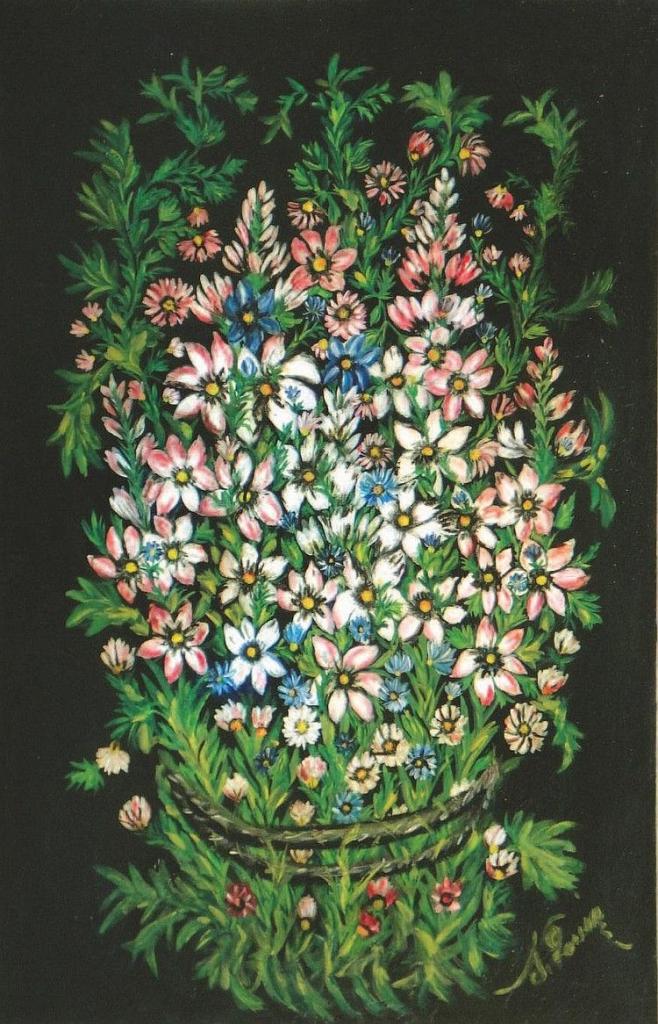Serafina Louis (1864-1942) - French self-taught artist, known for her large-format naive floral paintings, as can be seen from her work "Paradise Tree" (1928). She did not receive a formal art education and developed a peculiar style beyond the boundaries of established artistic traditions.
Seraphina Louis Biography
The artist was born in 1864 in a poor peasant community in Picardy, France. Since 1881, Serafina Louis spent 20 years as a sister in a monastery in northern France. She began to paint in 1903, after moving to Senlis, getting a job as an au pair. First, she decorated household items, and then began to transfer her decorative floral schemes to small wooden or cardboard panels. In 1921, her paintings attracted the attention of Wilhelm Ude, a German collector who discovered Picasso and Henri Russo. Ude included Serafina in his important exhibition, Artists of the Sacred Heart, in 1928, together with Andre Bauchan, Camille Bombois, Henri Russo and Louis Viven.

Over the years, Serafina plunged into visions, fantasies, and fell into madness. In 1932, after a decline in interest in her work, the artist suffered a mental breakdown and was placed in a psychiatric institution. Louis died there 10 years later, completely destitute, leaving the world of art his rich experience embodied in the paintings "The Garden of the Good Lord."
Despite the fact that Louis stopped painting, her works were shown at the exhibition “Popular Masters of Modernity”, organized at the Grenoble Museum in 1937, which opened in Paris and then visited Zurich and London. Alfred Barr adapted an exhibition for masters of folk painting (1938) at the MoMA in New York (Museum of Modern Art).
From the memoirs of William Ude
Tired of the hustle and bustle of Parisian life, of the brilliant exhibition that he had just dedicated to Henri Russo, in 1912 Wilhelm Ude rented a small apartment in Sanlis for a weekend break. One evening, having lunch at his neighbors' house, Ude noticed a small picture with apples in the corner of the living room. He was inspired by her beauty and skill, and asked the owners who drew it. He was told that this was a housekeeper, and that they wanted to buy a picture from her themselves, but they could concede to Uda for 8 francs.
The next day, when Serafina arrived at Uda’s home for work, she noticed that her painting was on a chair. Not a bit surprised, she laughed. Ude asked if Louis had any more paintings.
Serafina hastened home to Puit Tifan Street, rushed up the wretched staircase to the attic, grabbed a few canvases and hurried back. Ude was delighted. The paintings were as beautiful as the one he had already seen. In them, he discerned what Kandinsky called “inner necessity,” an impulse emanating from the very inner being of Seraphina, unsophisticated, unsullied, simple. Painted with rare freedom, covered with a kind of varnish, with the smallest details of the composition, the Seraphins of Louis, consisting of fruits, flowers and leaves, were given away by the illusions of the Middle Ages.
Creativity of the artist
Inspired by his religious beliefs, Louis painted ecstatic visions of fruits, flowers and foliage on plain or horizontally divided color fields made with oil or ripoline - household enamel paint. Compositions are dotted with shiny, gem-like plants that bloom out from tree trunks or vases. In later works, the figure and the earth merge into a tight weave, uniting the entire canvas with a pulsating, meandering rhythm.
The art of Seraphina Louis, inspired by nature, fields and forests in which she wandered as a child, 100 kilometers north of Paris, carries something supernatural. Louis's paintings, she said, were a response to the divine, to the orders of the Virgin Mary.
While most of the flowers depicted in the work of Louis, are figurative hybrids, she often painted ordinary daisies. In "Daisies" (pictured), Seraphina Louis depicts white flowers in swirls of thin strokes emanating outward from luminous spherical centers. A row of stylized leaves frame flowers in a mysterious dark field.
The painting “Leaves” has a more specific sense of space, even when the swarming mass of leaves merges distinctly with a yellow background. As in many of her later works, tiny strokes and dots of paint are decoratively grouped on the surface, giving the painting an extraordinary radiance.
The legacy of the artist
Bertrand Lorkin, curator of the Maillol Museum, in his introduction to the exhibition “Serafina Louis de Senlis” at the Maillol Museum in Paris, which took place from October 1, 2008 to May 18, 2009, spoke of the artist:
Serafina was an artist, obsessed with the irresistible desire to create "this famous inner necessity," of which Kandinsky spoke.
The paintings of Serafina Louis are exhibited in the museums of Mayol in Paris, the art of Saint-Lis and Nice and the contemporary art of the metropolis of Lille in Villeneuve d'Asc.
Film about the artist
In 2009, the French biographical film "Serafina" directed by Martin Provost received 7 Cesar awards, including for "Best Film" and "Best Actress" for Yolanda Moreau, who played the main role. The film explored the relationship between Seraphina Louis and Wilhelm Ude, from their first meeting in 1912 until the death of Seraphina.